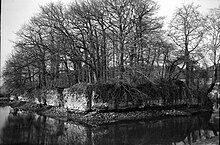House Rauschenburg (Olfen)
| Rauschenburg | ||
|---|---|---|
|
Remains of the wall in the southwest corner |
||
| Creation time : | First mentioned in 1050 | |
| Castle type : | Niederungsburg | |
| Conservation status: | Burgstall | |
| Standing position : | Nobles | |
| Place: | Olfen | |
| Geographical location | 51 ° 40 '56.8 " N , 7 ° 21' 29.1" E | |
| Height: | 44 m above sea level NHN | |
|
|
||
The Rauschenburg is a lost moated castle in the Lippewiesen on the outskirts of the small town of Olfen (Lehmhegge) in the North Rhine-Westphalian district of Coesfeld . Its name possibly goes back to the eternal rushing of the earlier rapids at this point in the Lippe.
history
The Rauschenburg manor was first mentioned in 1050, and the first owner was a bailiff of Bishop Ludwig Landgrave of Hesse from Münster in 1317 . In 1322 the bishop of Cologne, Heinrich von Virneburg , and the bishop of Munster signed a treaty in which the construction of a bridge over the Lippe on the Rauschenburg was decided. In 1444 and 1498 this contract was confirmed again by the sovereigns of the time.
In 1326, however, the castle belonged to Sweder von Rechede and was sold by the same to Reimbode von Landberge. In 1397, however, it was already owned by the von Oer family , who used it as a base for the troops of the Münster monastery . In 1418 the castles of Horneburg and Rauschenburg were besieged and finally conquered by the Archbishop of Cologne, Dietrich von Moers . The von Oer family was expelled, but in 1451 they signed a contract with them about the castle.
Around 1470 the castle came into the possession of Johann von Hake zu Wulfsberg near Lüdinghausen , who was then called Johann zu Rauscheburg. He had two daughters who each inherited half of the castle. At that time, the castle owned 20 farms north of the Lippe alone. However, the division of the inheritance led to a dispute. Daughter Margarethe was married to Johann von Ascheberg , while daughter Ursel was married to Alard von Hörde . Ursel died childless on March 9, 1564, after which Johann von Ascheberg considered himself the sole and legal owner of the manor. Bishop Bernhard von Raesfeld from Münster supported Alard von Hörde and moved with soldiers in front of the Rauschenburg, which was shot at until Johann von Ascheberg was captured. A settlement was later made, and both lived in the castle until Johann von Ascheberg's death in 1577. The property then passed to Johann's son and then to Johann's grandson Heinrich von Ascheberg, who died childless and thus put an end to the von Ascheberg's time on the Rauschenburg in 1638.
However, Heinrich von Ascheberg had a sister, Adolpha, who married Steffen von Neuenhoff in 1638 . The castle remained in the possession of the von Neuhoff family until 1770, after which it changed to the Rittmeister von Stockheim, who sold it to the cathedral chapter of Münster in 1783 . In the same year, however, Baron Werner von Brabeck , who lived at Haus Vogelsang , was named as the owner .
In a hereditary brotherhood between the von Brabeck and von Twickel zu Havixbeck families it was stipulated that ownership should fall to the other family in the event that one gender should die out. However, this resulted in several lawsuits, at the end of 1850 of which von Twickel zu Havixbeck was named as the owner. However, the castle was already taken possession of earlier, in 1820 at the earliest.
After that the castle fell into disrepair. In 1878 the upper floor was removed and used for a new bridge. The castle was inhabited until 1900, today only remnants of the foundation walls and cellar vaults remain.
construction
The Rauschenburg was built on a ford , over which horses and carts could sometimes be driven through the Lippe, on the otherwise impassable river to protect it. Nowadays there is a bridge at the place of the ford, over which the current federal highway 235 leads.
The castle had a three-storey main house with a tower, which was very similar to that of Horneburg Castle. It was surrounded by a moat , and a drawbridge connected the farm buildings and stables outside the moat with the main house.
literature
- Theodor Beckmann, Ingrid Breuer et al .: Datteln. Historical city guide. Volkshochschule der Stadt Datteln, Datteln 1993, pp. 81–84.
- Jens Friedhoff: House Rauschenburg. In: Kai Niederhöfer (Red.): Burgen AufRuhr. On the way to 100 castles, palaces and mansions in the Ruhr region. Klartext, Essen 2010, ISBN 978-3-8375-0234-3 , pp. 40–43.
- Albert Ludorff : The architectural and art monuments of the district Lüdinghausen (= The architectural and art monuments of Westphalia . Volume 1). Schöningh, Münster 1893, pp. 76-77 ( digitized version ).



